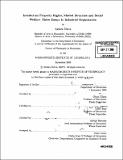Intellectual property rights, market structure and social welfare : three essays in industrial organization
Author(s)
Dutta, Antara
DownloadFull printable version (5.860Mb)
Alternative title
Three essays in industrial organization
Other Contributors
Massachusetts Institute of Technology. Dept. of Economics.
Advisor
Glenn Ellison and Nancy Rose.
Terms of use
Metadata
Show full item recordAbstract
This dissertation consists of three essays on the effects of intellectual property rights protection on market structure and social welfare in the Indian pharamaceutical industry. In contrast to pharmaceutical industries in the developed world, India had historically enforced a weak system of intellectual property rights protection that eliminated most legal barriers to entry in its pharmaceuticals markets. As a condition of its membership to the World Trade Organization, India became required to extend legal protection to all pharmaceutical products by 2005. The first essay analyzes the dramatic increase in the number of products released by domestic firms in India in the period leading up to the 2005 deadline. Speculation in the media linked this phenomenon to the imminent change in patent regime. The essay uses data on pharmaceutical products being sold in India in combination with data on drugs patented internationally to investigate the possibility that Indian firms launched products in the domestic industry as a strategic response to the anticipated change implied by the WTO. Results of the estimation do not provide conclusive evidence of strategic behavior by firms in markets where the patent enforcement could affect the future profitability of domestic firms. (cont.) The results suggest that much of the increase in product launches was driven by the size of the market and the age of the drugs in question. However, without more information on counterfactual current and future profits, we cannot rule out strategic behaviour by domestic firms. The second essay develops a structural model of demand, supply and entry and relates the free entry setting of the industry during the sample period to two sets of welfare issues. The model incorporates firm heterogeneity and product differentiation and backs out demand and supply-side parameters for five key therapeutic categories in the industry. Results of the estimation show that demand varies significantly across the therapeutic categories and that firm heterogeneity is an important factor for both demand and entry costs. Counterfactual simulations of the effect of entry by foreign firms into selected drugs find no evidence of socially "excessive" entry; on the contrary, the simulations suggest large gains to consumers from the addition of more firms, which would overwhelm the losses to producers and thus increase social welfare. (cont.) Simulations of the welfare effects of patent enforcement in India for four drugs that were under patent protection in the US at the time show losses of over $1 million on average for consumers in these markets and an average reduction in market size of approximately 35,000 patients. In comparison, the increase in profits of the global patent-holders for these drug are estimated to range between $0.08 million and $0.5 million. These gains are modest, particularly in comparison to the costs of global drug development that range between $200 million and $300 million. The third essay looks for empirical evidence of early-mover advantages for pioneering firms in pharmaceutical products markets in India. The first half of the paper employs fixed effects to control for unobserved heterogeneity. Estimates from this basic model suggest that an earlier entry translates into positive gains for firms, in terms of both higher prices and higher revenues. The second half of the paper tackles the sample selection issues arising from the fact that firms choose their own orders of entry. A firm's order of entry into a market is modelled as a continuous decision variable at the first-stage. The selection model then uses the residuals from this first-stage to correct the sample selection bias at the second-stage. (cont.) The order of entry continues to have a strong effect on the price and revenue received by a firm, with earlier entrants retaining larger long-term advantages. In particular, after accounting for the endogeneity of entry, results suggest that the pure order-of-entry effect on revenue allows the first entrant into a market to earn more than two times the revenue of the fifth entrant and over six times the revenue of the tenth entrant.
Description
Thesis (Ph. D.)--Massachusetts Institute of Technology, Dept. of Economics, 2006. Includes bibliographical references (p. 114-118).
Date issued
2006Department
Massachusetts Institute of Technology. Department of EconomicsPublisher
Massachusetts Institute of Technology
Keywords
Economics.